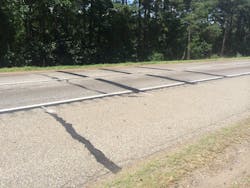Arkansas secures work zone on I-30
Arkansas Highway and Transportation Department (AHTD) Project BB0306, the Sheppard to Highway 278 project, entailed undercutting the inside shoulder and overlaying an asphalt surface on I-30. Earlier this summer, AHTD set up work zones and lane closures that ran from mile marker 22.4 to 29.5 on I-30, south and west of Hope, Ark., in both east and westbound directions.
The posted speed limit on I-30 is 70 mph; the section of I-30 within this project carries an ADT of 28,000 vehicles, with 45% of those 18 wheelers.
Because of the high speed, a higher concentration of trucks, and merging traffic, the possibility of severe crashes and fatalities was a significant concern.
AHTD traffic-control plans already call for “Reduced Speed Limit” signs, at 60 mph, and “Fines Doubled” signs. Rochelle Blue, AHTD District 3 resident engineer for this project, then added blue lights: Arkansas Highway Police cars were posted at each end of the work zones.
Project plans also included temporary portable rumble strips (TPRS):
- Each array consisted of three transverse strips, 11 ft long, installed 10 ft on center;
- An array was installed in each lane, travel and passing, 2 miles ahead of the lane-closure merge, on both sides of the interstate, east and west; and .
- An array also was installed 250 ft from the first, closer to the lane-closure merge, in both lanes, on both sides of the interstate.
Rochelle added the same TPRS configuration 6 miles out, when queues started to build beyond the 2-mile arrays.
The contractor chose RoadQuake 2 TPRS, manufactured by Plastic Safety Systems (PSS). RoadQuake 2 TPRS generates significant sound and vibration to alert the driving public to the upcoming work zones.
While the arrays were quite effective, Rochelle and others noticed that the first 2-mile array, the ones drivers encountered first, moved beyond an acceptable amount of a few inches per hour at that speed and ADT.
Further, the travel lane strips were moving into the passing lane. Adding to the puzzle, the array 250 ft ahead, the array closer to the merge, did not move beyond acceptable amounts, nor did they move into the other lane.
Having never witnessed that type of movement, PSS engineers visited with Rochelle at the site. They witnessed similar traffic levels, and similar movement in that one array.
Rochelle and our engineers analyzed the situation, and determined the cause:
- The percentage of truck volume was much higher than PSS test levels of 20-25%; and
- The road surface of the array that moved was old asphalt, significantly pitted and grooved, while the surface under the array closer to the merge was newer concrete.
Overall, the TPRS arrays were alerting drivers to the upcoming work zones. AHTD wanted them to remain on the road. To reduce movement, they decided to increase the frequency of the maintenance checks; when needed, the strips would be returned to their original locations.
As of this writing, this project is almost finished. All that remains is the punch list. There were no severe crashes or fatalities during construction.
